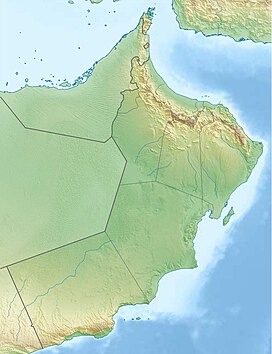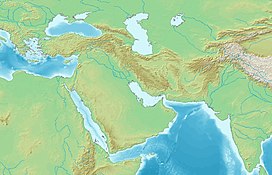| Hajar Mountains | |
|---|---|
| Oman Mountains[1][2] Rocky Mountains[3][4] Stone Mountains Asabon Mountains | |
 | |
| Highest point | |
| Peak | Jebel Shams, Oman |
| Elevation | 3,009 m (9,872 ft) |
| Naming | |
| Native name | Jibāl al-Ḥajar (جِبَال ٱلْحَجَر (Arabic)) |
| Geography | |
| Countries | |
| Region | Asia |
| Range coordinates | 23°18′N 57°06′E / 23.3°N 57.1°E |
The Hajar Mountains (Arabic: جِبَال ٱلْحَجَر, romanized: Jibāl al-Ḥajar, The Rocky Mountains[3][4] or The Stone Mountains) are one of the highest mountain ranges in the Arabian Peninsula,[5] shared between northern Oman and eastern United Arab Emirates. Also known as "Oman Mountains",[1][2] they separate the low coastal plain of Oman from the high desert plateau, and lie 50–100 km (31–62 miles) inland from the Gulf of Oman.
Al (اَلْ) means "the", and Ḥajar (حَجَر) means "stone" or "rock". So al-Ḥajar (اَلْحَجَر) is named as "the stone" or "the rock".
- ^ a b Allen, Calvin H. Jr. (2016-02-05). "1: Land and People". Oman: the Modernization of the Sultanate. Abingdon, New York: Routledge. pp. 1–8. ISBN 978-1-3172-9164-0.
- ^ a b Geukens, F. (1966). Bowers, S. D. (ed.). United States Geological Survey Professional Paper. Washington, D.C.: U.S. Government Printing Office.
- ^ a b Al-Yahyai, Sultan; Charabi, Yassine; Al-Sarmi, Said; Al-Maskari, Juma (2017-05-09). "3: Scenarios Based Climate Projection for Oman's Water Resources". In Abdalla, Omar; Kacimov, Anvar; Chen, Mingjie; Al-Maktoumi, Ali; Al-Hosni, Talal; Clark, Ian (eds.). Water Resources in Arid Areas: The Way Forward. Springer. p. 49. ISBN 978-3-3195-1856-5.
- ^ a b Megdiche-Kharrat, Fairouz; Ragala, Rachid; Moussa, Mohamed (2016-11-25). "12: The Aqueducts of the Sultanate of Oman: Sustainable Water-Supplying Irrigating Oases Cities". In Angelakis, Andreas N.; Chiotis, Eustathios; Eslamian, Saeid; Weingartner, Herbert (eds.). Underground Aqueducts Handbook. CRC Press. p. 206. ISBN 978-1-4987-4831-5.
- ^ "Al-Hajar Montane Woodlands and Shrublands". One Earth. Retrieved 2024-08-15.



